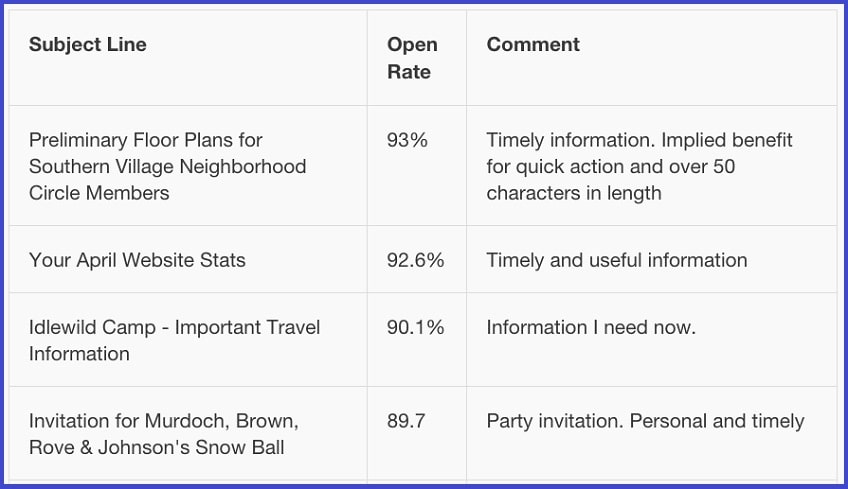In a congested inbox, the subject line of an email may determine whether or not it is opened or even noticed. In this piece, you’ll learn what it takes to consistently create amazing ones. In every relationship, the initial sentence sets the tone for what follows, and the same holds true with emails.
What Your Email’s Subject Line Conveys
Your subject line conveys the value of your email to the reader and motivates them to read further and, maybe, interact with your business more deeply by reacting to your CTA (CTA). A subpar subject line is worse than ineffective: It may lead to your email being tagged as spam, which can harm your reputation with customers and search engines.
Email’s Subject Line can get your email classified as spam
In fact, 69 percent of email receivers classify messages as spam based merely on the subject line. Even if your subscribers do not report an email as spam, the subject line is often used to decide whether or not to open it. Even in a post-MPP environment when open rate data is less accurate, subject line best practices should still be followed.
Your Email’s Subject Line Should be Artfully Written
Clever, attention-grabbing email subject lines may boost interaction and keep your emails in the inboxes of your prospects and clients. Therefore, it is essential to consider subject lines an integral element of your email marketing efforts, rather than a last-minute task to be finished just before sending. In this essay, we will discuss the best practices for email subject lines and provide samples of effective subject lines.
Email’s Subject Line: How to Write Effectively!
Let’s explore what goes into creating a subject line that connects with the receiver before looking at some particular examples of excellent email subject lines. Maintaining focus requires that you:
1. Subject line of an email must have the perfect length
You will need to test to see what length works best for your consumer base, but we suggest no more than 9 words and 60 characters. A few more or fewer words will not have a significant impact on your results, but too many words (over 20) or no words at all will.
2. Exclude the term “newsletter” from the Email’s Subject Line
The term “newsletter” should never appear in the subject line of an email. Open rates for emails are reduced by almost 19 percent when this term appears in the subject line, according to the data. This is due to the fact that people associate dull conventional newsletters with them, as opposed to yours, which will be jam-packed with useful information. Do not specify that you are, in fact, sending out a newsletter. In the subject line, always try to mention the worth of the email’s content.
3. A/B testing Your Email’s Subject Line is Essential
A/B testing on a few different subject lines is a terrific technique to ensure that the subject line you design is a winner. Among the many variables you may experiment with include word length, the use of comedy vs a more serious tone, the choice of words, and so on.
The finest open and engagement rates you’ve ever seen from an email marketing campaign will be yours once you know what form of subject line your audience enjoys and reacts to the most.
4. Avoid Special Characters, Spammy Words and SHOUTING
The subject line of your email should be as genuine as you can make it. Staying out of the spam folder is the best way to keep your reputation intact. The use of spammy language, special characters (# percent *@), and texts in ALL CAPS screams “spam” to receivers and ISPs alike.
These will at the very least result in an unsubscribe. They’re more likely to wind up in the junk mail. Some of the most prevalent spam terms include:
- F r e e
- Earn $
- Double your income
- Cash bonus
- Eliminate debt
- Extra income
- Fast cash
- Apply now
- Credit
- Explode your business
- Earn extra cash
- Auto email removal
- Billion
- Cheap
- Compare rates
Keeping your subject lines and emails out of the spam box is as simple as avoiding the most often used spam terms in the subject line.
Also, refrain from overusing exclamation marks.
5. Consider all the possibilities before making a decision.
Email subject lines may be written in a variety of ways, from the short and sweet to the personal to the keyword-specific and everything in between. Determine which of the various options best matches your brand’s personality and your audience’s preferences, and then get to work on your project..
Among the most common topic lines are:
- Question
- Local
- Urgent
- Clever/catchy
- Personal
- Trending topic
- List
- Short and sweet
- Sneak peek
- How-to
- Offer
- Scarcity
- Statistics
- Controversial
- Command
- Keyword
Here, you’ll find detailed instructions on how to make each and every one of them.
6. You shouldn’t be afraid of utilizing emojis.
When emojis were first launched, included them in an email subject line may have been contentious, but those days are long gone. Using emojis in subject lines has been shown to increase open rates, and clever email marketers are capitalizing on this. You’ll need to exercise caution while using them, however.
There are times when too many emojis might be seen as spammy or improper, especially if the tone of the email is more formal (like a business email). Using more than one emoji in a subject line is discouraged. To ensure that your emojis look the same across email clients and mobile devices, you should also test them.
Emojis may be a terrific addition to an email, but they should only be used sparingly and in accordance with the overall tone and branding of the email. And if you’d want to learn more about emoji best practices, check out this link!
7. Don’t forget to include preview text
If your email’s subject line serves as the headline, the preview content serves as the caption. It’s the text that appears after the subject line in your email subscriber’s inbox before they click onto the email. If you don’t change the preview text, it will be taken from the beginning of your email. This is fine, but if you really want to make your email stand out, try adding some preview text that adds value to your email.
Preview text provides you with more area to play off your subject line, tease the email content, and attract your subscribers’ interest – make the most of it! Good email subject lines stand alone, while outstanding email subject lines are accompanied with preview content.
Email’s Subject Line the 7 Best Practices
Now that we’ve gone over the fundamentals and provided you with lots of resources to create your own subject lines, let’s take a deeper look at some examples and the subject line best practices that make them effective.
1. Make them on time.
As these subject lines demonstrate, providing subscribers with the information they need at the time they require it increases open rates and email marketing success. These four newsletter subject lines demonstrate the importance of delivering information to subscribers on time. None of these subject lines are very brilliant, yet they all worked effectively because receivers desired the information provided.

Image: StudioJPilates
Automation is essential for sending the correct messages at the right time. Simple automated sequences, such as a welcome email series or an abandoned cart email, are some of the most effective emails you can send since they occur when the reader is paying attention.
2. Make them precise.
Sharing location-specific information shows your subscribers that you care about them. Because most people are naturally curious about local events, employing email subject lines like these might result in more clicks.
3. Make use of your numbers
Numbers may sometimes speak louder than words since they make information fast and simple to understand. Consider the following example:

How often does the subject line provide an obvious value to the receiver, but it is also sent by a real person. Using a person’s name in the sender section rather of an impersonal business or batch name enhances the likelihood that your newsletter will be opened and read.
4. For segmented audiences, use personalized subject lines.
Segmented email campaigns generate 760 percent more income than those sent to your whole email list. You may divide your audience into categories depending on a variety of variables, such as:
- Age
- Employment
- Buying habits
- Industry
- Gender
- Hobbies
- Geographical location
Of course, you can perform this work using email marketing, and then write laser-focused email subject lines to impress your segmented groups and increase the likelihood that they will open emails. Here are some excellent examples of subject lines that appeal to highly targeted audience segments:
- Attention Bostonians in Need of Weight Loss
- For Those Who Despise Paying Commissions
- Are you a Sales Professional looking to close more deals?
- What Every Investor Should Understand About IBM
- To the Road Warrior Who Despises Travel
- Corvette owners’ information is kept private
Investigating your audience’s interests and pain issues can assist your marketing team in developing subject lines that grab attention and increase open rates.
If you do a good job of segmenting, you may be able to send email subject lines like this:
- “Wow, this is your third visit this month!”
- “This is our way of saying thank you for dining with us last night [offer included]”
It is priceless to be able to express your gratitude to consumers. And if you can give them a customized subject line, it will instantly capture their attention.
5. It’s that time of year
Because consumers are seeking for holiday discounts as well as gift ideas, the holidays are an excellent time to send an email newsletter.
Here’s a collection of amazing holiday-themed subject line ideas for this season:
Check out the following sample to see how simple it is to use these keywords into your next campaign:
Your Weight Loss Resolutions for the New Year
Gifts for Dads and Graduation
Great Deals on Holiday Overstock
Your results will be much greater if you combine these subject lines with personalization and segmentation inside your content.
6. Astound them
Who doesn’t like a pleasant surprise? Hinting at a surprise within is a terrific method to enhance your newsletter open rate. You may use your subject line as a teaser, or you can provide a wider indication, such as informing readers about the kind of information they’ll get in your newsletter.
Giving your readers little goodies such as 3D material, infographics, guides, and floor plans makes opening your email seem like a present, which is a terrific approach to improve your value in their eyes.
7. Finally, FOMO.
FOMO, or Fear of Missing Out, is an excellent approach to get subscribers to check your email newsletter. The more urgency you can convey with your subject line, the more likely subscribers will desire to discover what your company has in store for them. Terms like “last opportunity,” “expiring,” or “limited time” are fantastic for instilling urgency, especially among eCommerce firms putting out an offer.
Just be sure you follow through on what your slogan promises. Opening a “urgent” email to find no genuine urgency in the email body can backfire on your marketing strategy and irritate your readers. Although you may notice a high open rate, your click-through rate and client experience may drop.
In Conclusion
Email is one of the most personalized media available in the world of digital marketing. It’s the ideal platform for fostering loyalty and trust between your subscribers and your business. By providing your subscribers with the information they want and desire, you can establish your company as the go-to source for value, whether it takes the form of content, goods, or services. However, you need to get your material in front of your subscribers in order to reach that stage in your connection with them.
To achieve that, it must pass the cursory scan of the inbox that the majority of individuals do while handling their daily deluge of emails. While creating a simple subject line might be quite simple, it can be more difficult to create one that increases opens and encourages readers to read your content again. We’ve provided you with a ton of effective, high-quality email subject lines that may serve as inspiration for your next email marketing campaign and assist your email newsletter establish itself as a regular inbox item.



